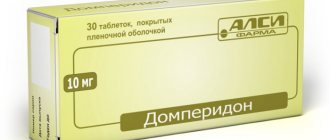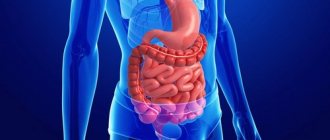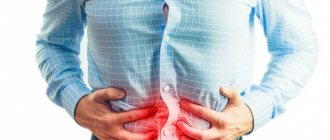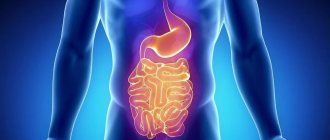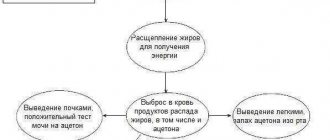Introduction
Fungus in the stomach (candidiasis) is a widespread and dangerous disease that requires immediate treatment .
However, it is insidious in that in the initial stages it proceeds almost unnoticed, and in advanced cases it is almost impossible to treat .
Many people confuse the disease with indigestion (due to similar symptoms) and do not take appropriate therapeutic measures, which can subsequently cause ulcers and dysbiosis. Therefore, it is important to diagnose the disease at the initial stage and follow the doctor’s recommendations, using both medications and folk remedies for recovery.
Treatment
Therapy for candidiasis occurs in several directions:
- taking medications whose components directly kill the fungal colony and the parasite itself - selective intestinal decontamination;
- treatment of diseases that caused the growth of the colony;
- diet therapy;
- taking a course of prebiotics that restore the natural antagonistic balance of the body.
All antifugal drugs suppress the synthesis of the parasite’s cell wall, but depending on the location of the colony’s development (intestines, stomach, esophagus), it is necessary to select a drug that is absorbed exactly in the right place.
Therefore, if the fungus has developed specifically in the intestines, drugs such as amphotericin B, itraconazole, ketoconazole, fluconazole, on the contrary, can cause specific side effects.
Based on the above, the most effective and universal are drugs that are not absorbed by the body:
- Levorin - contraindications include pregnancy, pancreatitis, renal failure, age less than two years, ulcers and individual sensitivity. Very versatile, well suited for the treatment of candidiasis in adults;
- Pimafucin is the only contraindication indicated, namely individual sensitivity. This is an advertised drug, approved for children of any age and pregnant women, and according to the manufacturer, it does not cause parasite resistance to the drug;
- Nystatin - has contraindications similar to Pimafucin, but the course of treatment is only 1-2 weeks.
Treatment with modern antifungal drugs is quite effective; a decrease in colony size is observed from the first day of taking them, and at the end of the course of treatment, mycological studies usually show a decrease in fungal inoculation, which is essentially a cure.
70-80% of adults are carriers of the fungus, therefore “fungal carriage” is not considered a disease and does not negatively affect the body.
The key to a speedy recovery is the fight against concomitant diseases, which must be treated taking into account the developed colony of fungal organisms.
The restoration of the antagonistic balance will later occur on its own, but in order to avoid relapses, it is better to help the body with this by taking prebiotics.
The causative agent of the disease and methods of infection
The causative agent of the infection is a fungus of the genus Candida , the presence of which is allowed in the microflora of the oral cavity and gastrointestinal tract (in small quantities). The spores of these fungi enter the body at the time of intrauterine development, being in the amniotic fluid and placenta.
Infection can also occur through the interaction of a newborn child with his mother (for example, during feeding) or in the case of close contacts with carriers of the fungus (at an older age). But these microorganisms do not pose a threat to the life of a healthy person, and, as a rule, begin to actively multiply when the immune system is weakened.
Favorable conditions for the development of Candida are two fundamental factors: the presence of a temperature of 20–27 degrees and an acidified environment in the body (disturbance in ph balance) .
Important!
The proliferation of the fungus is actively suppressed by lactobacilli, which act as a protective barrier in the stomach. Accordingly, the fewer beneficial bacteria become, the higher the likelihood of developing the disease.
Candidiasis of the intestines and esophagus
Esophageal candidiasis (otherwise known as candidal esophagitis) is accompanied by:
- heartburn, burning in the pharynx - these signs do not appear immediately, but after 2-3 weeks from the onset of the disease;
- the appearance of a white coating in the mouth with an unpleasant odor.
- difficulty swallowing (severe) due to blocking of the lumen of the esophagus with candidal films.
Intestinal damage by Cand fungi >
Common signs for the above types of candidiasis are:
- weakness, drowsiness, malaise,
- decreased ability to work,
- loss of appetite,
- elevated body temperature.
Causes of candidiasis
The occurrence of candidiasis is preceded by the following factors:
- Long-term use of antibiotics leads to disruption of the gastrointestinal microflora and increased fungal growth.
- Weakening of the immune system - dangerous microorganisms can enter the stomach not only through contact with people, but also through eating unwashed vegetables or fruits. However, if a healthy strong immune system fights and destroys fungi, a weak one will only contribute to their proliferation.
- Severe chronic diseases (kidneys, respiratory organs, diabetes) - as a result of violations of vital functions, the body also weakens and cannot cope with infection.
- Taking corticosteroid drugs - when used frequently, they cause stress in the body and a decrease in immunity.
- Stomach diseases (gastritis, peptic ulcer, low acidity, necrosis of some areas of the gastrointestinal mucosa) - destroy most of the lactobacilli, thereby creating favorable conditions for the fungus.
- The presence of tumor-like formations weakens the immune system and creates a comfortable environment for the development of candidiasis.
Important!
Experts also identify bad habits (smoking, alcohol and drug abuse) and a lack of vitamins in the body as additional factors.
How does a fungus develop?
Fungi are special microorganisms that live on the human body. They are present everywhere in small quantities. In a healthy body they do not manifest themselves in any way and do not cause harm. The activity of Candida fungi is controlled by special bacteria. When the body's protective functions decrease, an uncontrolled increase in the number of microorganisms occurs. As a result, a disease develops - candidiasis.
The development of fungus in the stomach occurs in two ways.
- Internal – weakening of the immune system. The functioning of beneficial bacteria fails and they no longer inhibit the proliferation of yeast fungi.
- External. Candida enters in large quantities through the oral cavity. Gradually, microorganisms adapt to the new environment and begin to gradually increase in number.
A healthy body copes with fungal bacteria received from outside and does not allow them to develop. When weakened, the fungus multiplies quickly, releasing harmful toxic substances. The mucous membranes of the digestive system are damaged, and ulcerative formations occur. The lumen in the esophagus decreases, and pain occurs when swallowing. Candidiasis in the stomach without treatment leads to intestinal dysbiosis.
At advanced stages of the disease, necrosis of the tissues of the stomach and esophagus occurs, treatment is useless.
Symptoms of mycosis of the intestines
While asymptomatic in the first stages, the disease later manifests itself as follows:
- Intense stomach pains - they can easily be confused with signs of gastritis or ulcers. The exact cause of discomfort can only be determined through diagnostics.
- Nausea and vomiting occur periodically (including after eating). The vomit may contain characteristic white films and blood.
- The presence of a white coating on the tongue (including on the lips and cheeks on the inside) resembles cheesy formations.
- A sharp change in the taste of familiar foods - the patient may be irritated by once favorite foods and vice versa.
- An unpleasant taste in the mouth - often occurs after waking up, but can occur at any other time.
- Diarrhea and bloating are also present periodically.
- The presence of foreign impurities in the stool - patients can often find traces of blood and white plaque.
- Pain when swallowing food - the fungus affects the gastric mucosa, leaving white films, which can subsequently partially or completely block the lumen of the esophagus. This causes discomfort when swallowing.
- Decreased or lack of appetite - may be present against a background of nausea and pain in the epigastric region.
- Heartburn and belching are usually observed after eating.
Important!
Candidiasis worsens a person’s general well-being, causing weakness and increased body temperature.
Treatment of gastrointestinal candidiasis
An important factor in successfully getting rid of candida infection is timely therapy, which prevents the fungal spores from spreading further into the deep layers of the walls of the digestive organs.
Treatment of candidiasis of the stomach and esophagus is carried out with antimycotics (antifungal drugs) - Pimafucin, Nystatin, Levorin, Fluconazole, which are characterized by poor absorption in the gastrointestinal tract.
This specificity of the drug allows it to act in the cavity of the affected organ without having a negative effect on the body as a whole. In severe cases of the disease, drugs are prescribed intravenously: Ampholip or Amphotericin.
To increase the effectiveness of therapy, it is recommended to use eubiotics (live or dried microorganisms and bacteria) that restore microflora: Linex, Hilak-Forte, medicinal yoghurts. More than 4 weeks will be required to normalize the microflora and cure gastric candidiasis.
Drugs for symptomatic therapy:
- for stomach pain - Pantoprazole or Omeprazole,
- for nausea and vomiting – “Cerucal”,
- for prolonged diarrhea - Imodium,
- for heartburn - Ranitidine,
- for intestinal bloating - “Polysorb” or “Enterosgel”.
The dosage and duration of treatment are prescribed by the doctor; It is not recommended to independently treat gastric candidiasis with pharmaceutical drugs. In mild cases, treatment can be carried out on an outpatient basis, in difficult cases - in a hospital.
Course of the disease
Often the disease affects the oral cavity, esophagus and intestines, occurring through several successive stages:
- The first stage is deterioration of appetite and distortion of the taste of food. If the pharyngeal mucosa is affected, difficulty and pain when swallowing may occur.
- The second is nausea, vomiting, stool upset.
- The third is an increase in temperature, weakness, decreased activity, and a general deterioration in well-being.
- The fourth is pain in the abdomen (mainly in the upper part), as well as blood and mucus in the vomit. At this stage, serious consequences are possible, such as: the appearance of through ulcers on the walls of the stomach, peritonitis and internal bleeding.
- The latest stage is infection of the intestine with severe damage to its walls.
Types of candidiasis
In the medical classification, depending on the root cause of the fungus in the intestines, its treatment depends, therefore the following forms of the disease are distinguished:
- Non-invasive candidiasis is the most popular reason why such a fungus occurs in the intestines; the symptoms are subtle and treatment requires care. Candida develops a colony in the intestinal lumen, but the parasite still does not penetrate through the mucous membranes. It is dangerous because the colony “throws out” toxic products of its vital activity into the body; they have a destructive effect on the digestive system.
- Invasive form - it is rare to encounter, and its course is severe; typical carriers are people with HIV (AIDS), tuberculosis, and cancer patients. The parasite develops throughout the body, causing organ damage, in particular, fungal infection of the esophagus, and if the patient has gastric ulcers, the disease develops into focal candidiasis (stomach fungus).
- Perianal candidiasis is an extremely rare form; the target site for colony development is the rectal mucosa and anus. A characteristic “signal” from the body that it needs treatment for fungus in the intestines is regular abdominal pain and stool disturbances. Many people do not pay attention to this for a long time, delaying treatment and complicating it accordingly.
Diagnostics
If you have characteristic symptoms, you should consult a gastroenterologist as soon as possible and carry out a number of the following diagnostic measures:
- Analysis of vomit particles - in case of candidiasis, a large amount of pseudomycelium will be detected.
- A swab from the patient’s mouth will help identify the causative agent of the infection.
- Endoscopy (examination of the stomach from the inside using an endoscope) - the presence of the disease will be indicated by inflamed walls of the organ with a yellowish-white coating.
- A blood test for immunological reactions will help identify antibodies to the pathogen.
In addition, candidiasis can be diagnosed if the following signs are present (based on laboratory tests):
- low acidity;
- low level of immunoglobulin.
Important!
The effectiveness of subsequent treatment will depend on correct diagnosis. Therefore, a specialist needs to accurately determine the type of candida.
Symptoms of the disease
In the initial stages, this disease is very difficult to diagnose, since it is practically asymptomatic. Even in later stages, patients with candidiasis do not often seek medical help, mistaking the symptoms of their illness for signs of other, less dangerous gastric diseases.
The main symptoms of candidiasis are the following:
- diarrhea;
- flatulence;
- nausea and vomiting;
- frequent false urges;
- in advanced stages of the disease, blood appears in the stool;
- whitish impurities similar to curd mass may be found in feces;
- pain in the stomach;
- change in the taste of products;
- white cheesy coating on the tongue.
In addition, the disease also affects the general condition of a person: he is overcome by weakness, at times the temperature may suddenly rise, and various colds occur more often.
Treatment of the disease
To treat the fungus, patients are prescribed special medications, but folk remedies can also be used as additional therapy. Advanced stages of candidiasis usually require hospitalization.
Drug therapy
To combat fungus in the stomach, approximately the following drugs are recommended for patients. Antimycotics are antifungal drugs used in the early and middle stages of the disease. These include:
- Nystatin is a highly effective remedy in the fight against fungi of the genus Candida. Can be used for preventive purposes. The average daily dose is 3–4 tablets. The course of treatment is about 2 weeks. The drug can be purchased at a cost of 135 rubles per package (100 pieces).
- Fluconazole is an antifungal agent used in the early stages. Adults are prescribed 4 capsules per day. The drug is produced individually, the average price is for 1 piece. is 33 rubles (150 mg). Price for 7 capsules of 50 mg - from 60 rubles.
- Lamisil is a broad-spectrum antifungal agent that inhibits the activity of fungi and prevents their reproduction. Daily dose - 1-2 tablets. The average price is from 2200 for 14 pieces.
Important!
Antibiotics for the treatment of candidiasis are not recommended, because they can further weaken the immune system and thereby cause the proliferation of fungi.
Products for restoring and normalizing intestinal microflora contain live cultures and are prescribed after a course of antifungal drugs. These include:
- Linex - adults are recommended to take 2 capsules 3 times a day (mainly after meals), with plenty of water. The average price is 280 rubles (16 pcs.).
- Lactofiltrum is a plant-based drug with an immunostimulating effect. It is recommended to take 2-3 tablets 1-1.5 hours before meals three times a day. The product can be purchased at a cost of 270 rubles (30 pcs.).
Drugs for intravenous injection - prescribed for severe stages of the disease. These include:
- Amphotericin - dosage is determined by the attending physician. The average cost is 37 rubles (10 ml).
- Ampholip - quickly distributed in organs and tissues, destroying the fungus. Patients are usually prescribed 1–3 ml per day. The average price is from 10,300 rubles (10 ml).
Important!
Before using this or that product, you must consult a specialist; self-medication is unacceptable. Otherwise, complications and irreversible consequences are possible.
Folk remedies
Folk remedies are applicable only in the early stages of the disease (as part of complex therapy). Here are some of them.
Herbal decoction with antifungal effect
Ingredients: sage, wormwood, oak bark powder, black poplar bud powder, goldenrod (1 tablespoon each).
Preparation: mix the ingredients and pour a glass of boiling water, heat in a water bath (15 minutes), drain and strain.
Application: consume 30–40 ml on an empty stomach. It is also recommended to treat the oral cavity: take it into your mouth and spit it out after a while (the duration of the procedure is 30–40 minutes). Use for 10 days, then take a 7-10 day break. In case of allergic reactions and deterioration of health, treatment should be stopped.
Freshly squeezed carrot juice
Squeeze the juice from fresh carrots and take 1 glass on an empty stomach. Use until the condition improves.
Oatmeal jelly
Preparation: pour 10 glasses of oats with water (7 liters). Cook for 3 hours over low heat, cool and strain.
Application: take 100 grams 3 times a day.
It is also recommended to eat garlic (2-3 cloves per day). But this method is strictly contraindicated for gastritis and stomach ulcers.
Medicines and folk remedies
What drugs are used to treat candida fungus in the stomach?
Medicines:
- Fluconazole. One of the most popular and effective drugs. Used for mild forms of the disease, take 100-150 mg twice a day.
- Nystatin - used for fungal diseases in the stomach and intestines. Take one or two tablets up to four times a day.
- Levorin. Fast-acting antifungal agent. Prescribe one capsule up to four times a day.
- Linex, Hilak, Bactisubtil are medicines aimed at restoring and normalizing intestinal microflora.
- Ampholip, Amphotericin are medications used by injection in severe stages of the disease.
- For heartburn, Ranitidine is allowed, for nausea, Ceprukal, and for intestinal upset, Imodium is prescribed.
All medications are selected individually for each patient. Self-treatment of this disease is impossible. Traditional methods of therapy can be an addition to the main treatment.
Ethnoscience:
- Application of essential oils. A couple of drops of lavender, myrrh, oregano or tea tree oil are diluted in 50 ml of water. You need to drink one small spoon before meals.
- Decoctions are prepared from oak bark, chamomile, St. John's wort, and black poplar buds and drunk before meals.
- After eating, you can rinse your mouth with soda or blue iodine.
- Eating a few cloves of garlic a day will help you cope with the disease faster.
- Oatmeal jelly is easy to prepare, and its benefits are enormous. Ten glasses of oats are poured with 7 liters of water. Cook for three hours over low heat, filter. Take one hundred grams three times a day.
There are many recipes, but folk remedies do not cope with fungal diseases like medications. They must be used with caution and for a long period.
Prevention
To prevent illness, you must adhere to the following recommendations:
- Observe precautions when taking antibiotics and hormonal drugs (without abusing them).
- If you notice any suspicious symptoms, contact your doctor as soon as possible. institution.
- Treat chronic diseases in a timely manner.
- Take multivitamins and eat right (more fiber, fresh vegetables and fruits).
- Give up bad habits (drinking alcohol, smoking) and lead a healthy lifestyle.
Diagnosis of stomach disease
A faster result of identifying the pathogen can be obtained using the polymerase chain reaction (PCR). Antibodies to Candida fungi make it possible to detect immunological reactions.
If candidiasis of the esophagus and stomach is suspected, a laboratory examination of the patient's feces and vomit is carried out in order to identify threads of fungi. Treatment is prescribed after an accurate diagnosis.
Diagnosis of the disease
The presence of the disease can be assumed already during a physical examination of the patient, since candidiasis often develops in the oral cavity or on the skin. The presence of fungus on the skin and oral mucosa confirms the presence of the disease, but its absence does not guarantee that it is not present in other parts of the gastrointestinal tract.
Smears may be taken to confirm gastric and esophageal candidiasis. A cytology brush or balloon catheter is used, which is inserted through the mouth or nose, and a probe is used to prevent contamination. The taken material is examined under a microscope; if budding yeast-like fungi, mycelium and pseudomycelium are found in it, then the diagnosis is considered confirmed. Vomit may also be examined.
Endoscopic examination allows us to assess the degree of gastric candidiasis and the localization of lesions. During an examination with an endoscope, the doctor not only sees the mucous membrane of the esophagus and stomach, but can carry out medical procedures, for example, take tissue for histological examination and material for culture, cauterize minor bleeding, remove a polyp, determine the acidity of gastric juice and whether Helicobacter is present.
Causes
Against the background of decreased immunity, in the presence of inflammation, the development of thrush becomes uncontrolled and causes harm to the body. Stomach fungus actively reproduces for the following reasons:
- the presence of ulcers, gastritis, and other gastrointestinal diseases;
- necrosis and damage to the mucous membranes of internal organs;
- HIV infection;
- presence of dysbacteriosis;
- previous surgery;
- injuries;
- diabetes and other endocrine disorders;
- neoplasms of malignant and benign nature;
- chronic pathologies of the respiratory system and kidneys;
- prolonged uncontrolled use of antibiotics and other medications that lead to disruption of the flora.
How is pathology diagnosed?
Candidiasis of the esophagus is diagnosed based on anamnesis, objective examination, the use of instrumental and laboratory research methods, and x-ray diagnostics. X-ray of the esophagus using a contrast solution reveals strictures and anatomical changes. Not suitable for early detection of pathology.
The recognized diagnostic standard is endoscopy. Allows you to see foci of fungal infection, assess the condition of the mucous membrane, the presence of structural changes, and the extent of the process.
Targeted biopsy is performed in combination with FGDS. Suspicious areas and foci of inflammation are examined.
Laboratory diagnostics include: culture of flora, sensitivity of esophageal fungi to antimycotics, determination of immune status, presence of antibodies and their concentration.
Timely and correct diagnosis allows you to prevent complications and select effective therapy.
Possible complications of gastric candidiasis
Long-term, untreated gastric candidiasis can lead to the development of complications:
- chronic gastritis;
- peptic ulcer;
- stomach bleeding;
- perforation of the stomach wall and the development of peritonitis.
It has also been established that chronic candidiasis creates conditions for the development of stomach cancer.
